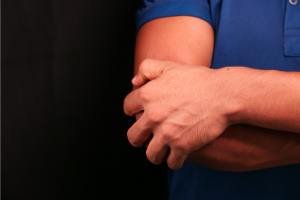What is Golfer's Elbow?

Golfer’s Elbow, medically referred to as medial epicondylitis, stands as a prime example of a repetitive stress injury (RSI) that stems from the repercussions of consistent and protracted movements or actions, which place undue strain on the tendons and muscles residing within the forearm. This strain manifests itself through the emergence of inflammation and discomfort, primarily concentrated at the inner aspect of the elbow. Remarkably, the discomfort can extend its reach along the forearm, occasionally extending all the way to the wrist. Although its nomenclature might suggest a direct link to the sport of golf, it’s important to note that Golfer’s Elbow isn’t solely confined to golfing activities. In truth, a multitude of activities encompassing various domains can serve as potential triggers for the development of Golfer’s Elbow.
The activities that can lead to someone developing Golfer’s Elbow, which often involve repetitive gripping, wrist flexion, and the rotation of the forearm, can collectively contribute to the gradual onset of Golfer’s Elbow.
Can Golfer's Elbow cause wrist pain?
Golfer’s Elbow causes wrist pain and inflammation of the tendons and muscles that attach to the inner side of the elbow. These tendons also connect to the wrist and hand, so the pain and inflammation from Golfer’s Elbow can sometimes extend down the forearm and affect the wrist. It’s not uncommon for individuals with Golfer’s Elbow to experience discomfort and pain in both the inner elbow and the wrist due to the interconnected nature of the tendons and muscles involved.
How do I know if I have Golfer's Elbow?

Determining whether you have Golfer’s Elbow involves recognizing specific symptoms and considering your recent activities. If you’re experiencing pain and discomfort around the inner side of your elbow, here are some common signs and steps to help you assess if you might have Golfer’s Elbow:
Pain: Persistent or intermittent pain on the inner side of the elbow, which can sometimes extend down to the forearm and wrist.
Tenderness: The affected area is tender to touch, especially near the bony bump on the inner side of the elbow (medial epicondyle).
Stiffness: The elbow and forearm might feel stiff, particularly after periods of rest or upon waking up.
Weakness: You may notice a decrease in grip strength and difficulty performing tasks that involve gripping or lifting.
Pain Aggravation: Activities that involve wrist flexion, gripping, or repetitive movements can worsen the pain.
Pain Radiation: If you have Golfer’s Elbow pain, your discomfort might radiate from the inner elbow down to the forearm or the wrist.
Numbness or Tingling: In some cases, you might experience tingling or numbness in the fingers, but this is less common with Golfer’s Elbow than with conditions like carpal tunnel syndrome.
If you are experiencing these symptoms and need treatment for Golfer’s Elbow, consult a healthcare professional for a proper diagnosis.
What triggers Golfer's Elbow pain?
Golfer’s Elbow pain is typically triggered by activities that involve repetitive wrist flexion, gripping, and forearm rotation. Some common triggers are:
– Repetitive swinging and gripping motions in golf
– Repetitive gripping of tools, racquets, or objects
– Lifting objects with improper form or using the wrist excessively
– Forceful throwing motions in sports
– Prolonged typing or using a computer mouse with poor wrist alignment
– Repetitive tasks in manual labor jobs
– Gripping tennis or squash racquets tightly
– Poor technique during weightlifting
– Repetitive motions while painting
– Playing musical instruments that involve repetitive finger and wrist movements
Engaging in these activities without proper technique, using appropriate equipment, or taking breaks can contribute to Golfer’s Elbow pain.
Mild to moderate cases of Golfer’s Elbow can often be effectively managed through a combination of proper rest and self-care strategies. Ignoring the condition or failing to implement suitable measures could lead to the persistence or even worsening of Golfer’s Elbow symptoms over time. Hence, it becomes essential to adopt proactive steps aimed at addressing the discomfort and promoting the healing process.
Can you get Golfer's Elbow pain from activities other than golf?
You can experience Golfer’s Elbow pain from activities other than golf. While Golfer’s Elbow is commonly associated with golf due to the repetitive swinging and gripping motions involved, it can also result from other activities that strain the wrist flexor tendons and forearm muscles. Any activity that requires repetitive gripping and forceful hand movements can contribute to Golfer’s Elbow. Golfer’s Elbow can worsen when these activities are repeated. Some of these activities include:
– Weightlifting
– Racquet Sports
– Throwing
– Typing and Computer Use
– Manual Labor
– Playing Instruments
– Painting
How can the FICOR Fit band help relieve Golfer's Elbow pain?
The FICOR Fit wristband relieves Golfer’s Elbow pain through its targeted compression and support. By applying gentle pressure to the affected area, it helps reduce strain on the tendons and muscles that contribute to pain. This compression can reduce inflammation, improve blood flow, and promote healing. The wristband’s design allows for a comfortable fit and unrestricted movement, making it suitable for wearing during activities that may trigger Golfer’s Elbow and wrist pain.
Is it okay to wear the FICOR Fit band at night for Golfer's Elbow pain relief?
Wearing a FICOR Fit wristband at night for Golfer’s Elbow pain relief can provide continuous support and compression to the affected area. The wristband offers support, reducing swelling and inflammation in the tendons and muscles, helping to stabilize the joint and reduce strain during sleep. It can improve blood circulation and promote healing. By limiting certain movements during sleep, the wristband can prevent accidental aggravation of the condition, allowing the affected area to rest and recover. The combination of support, compression, and restricted movement can contribute to reduced pain and discomfort during the night and upon waking.


